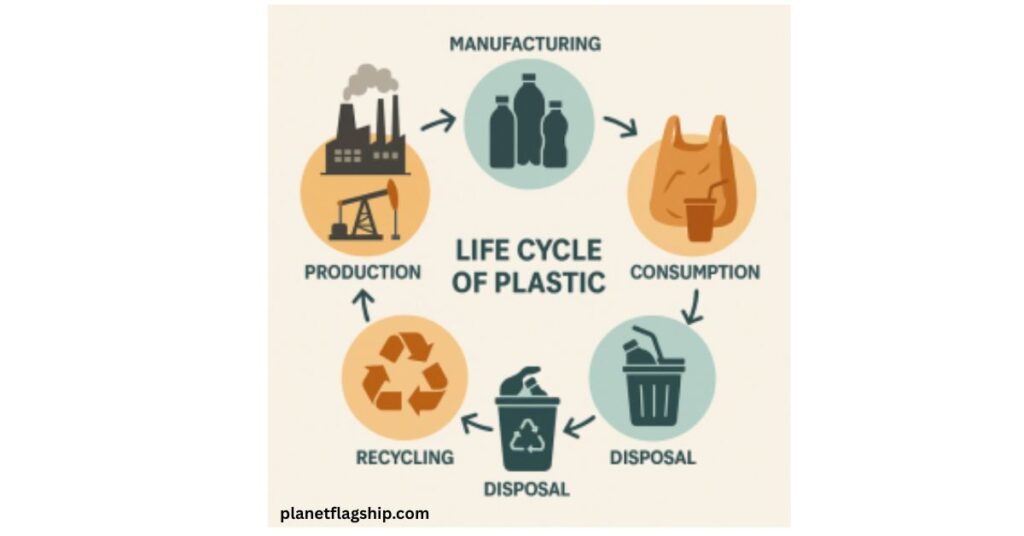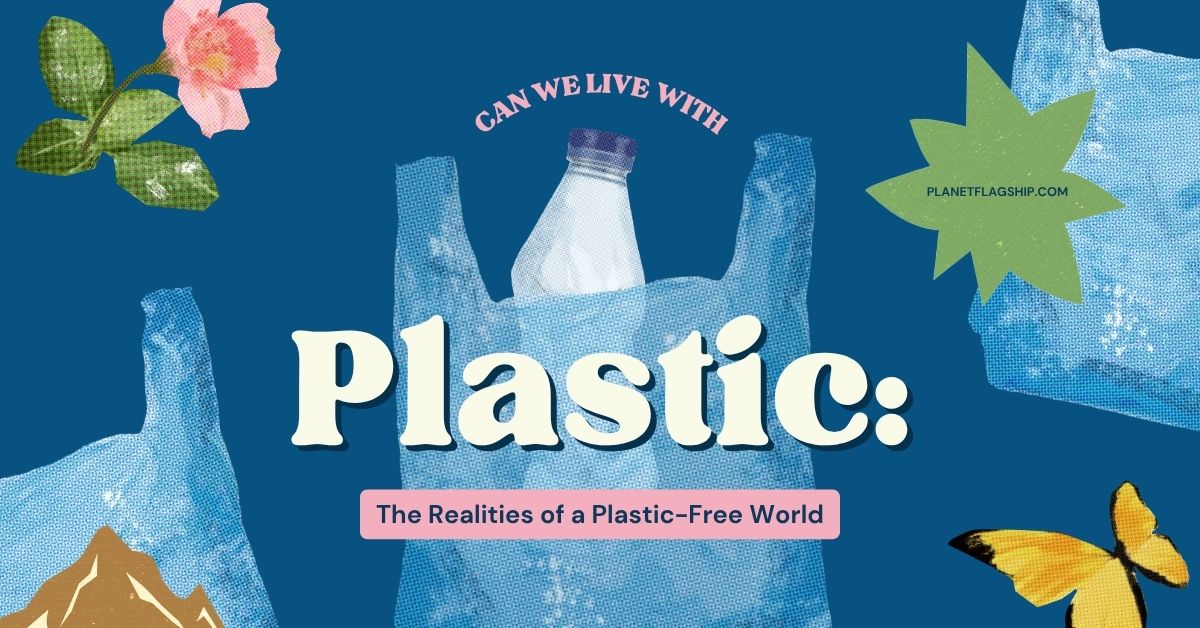Introduction
Plastic is one of the most transformative inventions in human history. From the toothbrush you use in the morning to the smartphone in your pocket, plastic is everywhere. It is lightweight, durable, cheap, and versatile. These properties made it a miracle material when it was first introduced on a commercial scale in the 1950s. Since then, global plastic production has skyrocketed, reaching over 400 million tonnes annually (UNEP, 2021), a number projected to double by 2040 if no interventions are made.
But the very characteristics that make plastic so convenient are also what make it a lasting threat to our planet. It takes hundreds of years to decompose, leaches harmful chemicals, chokes marine life, and enters the human body in the form of microplastics. This has led many to ask: Can we live without plastic? What would a plastic-free world look like? Is it even feasible?
This article delves into the necessity of plastic, the environmental and health challenges it poses, and the global movement toward reducing and replacing it. We will explore sustainable alternatives, individual and collective solutions, and whether a truly plastic-free lifestyle is attainable in today’s interconnected world.
The Global Plastic Crisis

Plastic is everywhere, from the obvious grocery bags and water bottles to the less visible parts of our lives, such as car interiors, insulation materials, and food packaging. The dependency is not only due to cost-effectiveness but also because plastic can be molded, stretched, and shaped into nearly any form.
Some key statistics to consider:
- Over 50% of plastic produced is single-use (UNEP, 2021).
- Only 9% of plastic ever produced has been recycled (Geyer et al., 2017).
- About 11 million metric tons of plastic waste enter the oceans each year (The Pew Charitable Trusts, 2020).
These numbers expose the overwhelming scale of the plastic problem and why action is urgently needed.
READ MORE: Climate Change and Inequality: The Growing Divide Between Rich and Poor Countries
Health and Environmental Implications
Most plastic waste ends up in landfills or the natural environment. Once there, it does not biodegrade—it breaks down into smaller particles called microplastics, which are now found in the deep sea, mountaintops, and even the air we breathe.
Threats to Marine and Terrestrial Life
Marine animals often mistake plastic for food. Turtles eat plastic bags thinking they are jellyfish; seabirds ingest bottle caps and straws. This causes choking, starvation, or internal injuries. On land, plastic blocks soil aeration and leaches harmful chemicals into the ground and water systems.
Microplastics in the Human Body
One of the most alarming discoveries in recent years is the presence of microplastics in human organs and blood (Leslie et al., 2022). These particles can carry toxic chemicals like phthalates and bisphenol A (BPA), which disrupt hormones, affect reproductive health, and potentially lead to cancer.
Plastic: The Modern Necessity
Where Plastic Is Indispensable
Eliminating plastic is not as straightforward as it seems. Plastic plays a crucial role in:
- Healthcare supplies include surgical gloves, syringes, catheters, and IV bags.
- Food safety: airtight packaging prevents contamination and extends shelf life.
- Construction: pipes, insulation, waterproofing
- Technology: circuit boards, casings, wiring.
- Without plastic, the cost of producing and distributing many essential items would significantly increase, potentially making healthcare and basic services inaccessible to many.
Exploring Alternatives: Are They Enough?
- Bio-plastics, made from renewable resources like cornstarch or sugarcane, are marketed as eco-friendly. However, they are not a silver bullet.
- Require industrial composting facilities (which are not widely available).
- It may still release methane during degradation.
- It is often blended with traditional plastic, which complicates recycling.
Reusable Materials
- Materials like glass, stainless steel, and aluminum offer high durability and are infinitely recyclable, but:
- Glass is heavy and fragile, increasing transport emissions.
- Metal mining has a large ecological footprint.
- Paper decomposes quickly but lacks moisture resistance without a plastic coating.
Natural Packaging Innovations
Innovators are experimenting with mushroom-based foam, seaweed wrappers, banana leaves, and edible cutlery. While these options are promising, they remain niche and are not yet affordable or scalable enough to replace plastic globally.
Can We Really Live Without Plastic?

Living without plastic might be possible on a small scale, but eliminating it globally would require complete redesigns of supply chains, production systems, and consumer behavior.
A more realistic approach is to:
- Phase out non-essential plastics.
- Innovate sustainable materials.
- Educate consumers about reuse and recycling.
- Build robust waste management systems.
- Plastic should not be eliminated; it should be used wisely and disposed of responsibly.
Case Studies: Countries Tackling Plastic
The EU banned several single-use plastic items in 2021, including plastic cutlery, plates, straws, and expanded polystyrene food containers. Countries are now transitioning to extended producer responsibility (EPR) models, where companies are accountable for the life cycle of their packaging.
India
India banned single-use plastic items in 2022. However, enforcement remains a challenge due to informal economies and inadequate alternatives.
Kenya
Implemented one of the world’s strictest plastic bag bans in 2017, including heavy fines and jail time. Though effective, it also led to a black market for plastic bags.
Canada
Banned the manufacturing and import of harmful single-use plastics such as plastic checkout bags, cutlery, and food containers, beginning in 2023.
MORE READ: Chemical Pollution: How It’s Silently Damaging Human Health
What Can Individuals Do?
- Everyday Actions That Matter.
- Carry reusable bags, water bottles, and food containers.
- Reject straws and single-use utensils.
- Choose bar soaps, bamboo toothbrushes, and refillable products.
- Buy second-hand to avoid packaging waste.
- Support zero-waste stores and eco-conscious businesses.
- Community and Policy Involvement.
- Individual action alone is not enough. We need:
- Local waste segregation and composting programs.
- Education in schools about plastic and the environment.
- Lobbying for policy changes, such as plastic taxes or bans.
Rethinking Convenience Culture
Plastic often serves our desire for convenience. Fast food, online shopping, and disposable products are built around ease, not sustainability. Breaking away from this mindset is essential to reducing our dependence.
The Role of Industry and Innovation
- Sustainable Packaging Trends.
- Refill stations for household goods like shampoo and detergent.
- Bulk food stores use glass or compostable containers.
- Product redesign to reduce plastic use (e.g., toothpaste tablets).
- Startups and Tech Solutions.
- Companies like Loliware are creating edible straws.
- Notpla uses seaweed to make biodegradable sachets.
- Loop delivers brand-name products in reusable containers with deposit schemes.
- These innovations show promise, but need scale, investment, and consumer buy-in.
FAQs on Living Without Plastic
Is it really possible to live without plastic?
Living completely without plastic is extremely difficult in today’s world. Plastic is deeply integrated into essential sectors like healthcare, technology, and food safety. However, we can drastically reduce our dependence by avoiding single-use plastics, reusing materials, and supporting sustainable alternatives.
What are the biggest challenges to a plastic-free world?
The main challenges include affordability, scalability of alternatives, and convenience culture. Many eco-friendly materials like bioplastics or mushroom packaging—are still expensive and not widely available. Transitioning away from plastic requires innovation, investment, and behavior change.
What are the best alternatives to plastic?
Promising alternatives include glass, stainless steel, paper-based packaging, and biodegradable bioplastics made from cornstarch or seaweed. While these materials are eco-friendlier, each comes with trade-offs such as cost, durability, and environmental footprint.
How does plastic pollution affect human health?
Plastic pollution leads to microplastics entering our food, water, and even bloodstreams. Studies show that chemicals like BPA and phthalates from plastics can disrupt hormones, harm reproductive health, and increase cancer risks.
What can individuals do to reduce plastic waste?
Simple lifestyle changes can make a big impact carry reusable bags, bottles, and containers, avoid products with excessive packaging, and support zero-waste stores. Advocating for plastic bans and recycling programs in your community also drives large-scale change.
Conclusion
While living without plastic is theoretically possible, it is practically unrealistic at this stage of global development. Plastic has become deeply embedded in critical sectors such as healthcare, food safety, and technology. However, this does not mean we are powerless. The true path forward lies not in eliminating plastic, but in rethinking how we produce, use, and dispose of it.
We must phase out unnecessary single-use plastics, invest in sustainable alternatives, and, most importantly, change our habits and expectations. Individuals, communities, industries, and governments all have a role to play. Whether it’s choosing a reusable cup, supporting plastic-free policies, or developing compostable materials, every action counts.
Let us aim not for a plastic-free fantasy, but for a plastic-responsible reality—where convenience never comes at the cost of our planet’s future.
References
- Leslie, H. A., et al. (2022). Discovery and quantification of plastic particle pollution in human blood. Environment International, 163, 107199. https://doi.org/10.1016/j.envint.2022.107199.
- United Nations Environment Programme. (2021). From Pollution to Solution: A Global Assessment of Marine Litter and Plastic Pollution. https://www.unep.org
- World Bank. (2022). What a Waste 2.0: A Global Snapshot of Solid Waste Management. https://datatopics.worldbank.org/what-a-waste/
- Geyer, R., Jambeck, J. R., & Law, K. L. (2017). Production, use, and fate of all plastics ever made. Science Advances, 3(7), e1700782. https://doi.org/10.1126/sciadv.1700782.
- The Pew Charitable Trusts. (2020). Breaking the Plastic Wave: A Comprehensive Assessment of Pathways Toward Stopping Ocean Plastic Pollution. https://www.pewtrusts.org
- Sharma, S., & Chatterjee, S. (2017). Microplastic pollution, a threat to marine ecosystem and human health: a short review. Environmental Science and Pollution Research, 24(27), 21530–21547.

John is a professional blogger and passionate advocate for environmental sustainability. With years of experience exploring eco-friendly practices and green innovations, he shares insightful articles on Planet Flagship to inspire a sustainable future. John’s expertise lies in making complex environmental topics accessible and actionable, empowering readers to make meaningful changes for the planet.
